3 Process approach
3.1 Types
Types, components, elements, management, realization, support
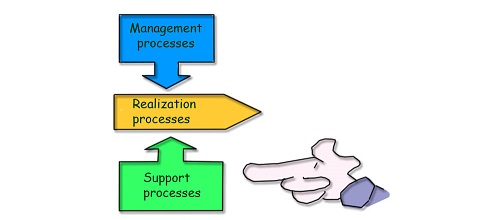
If you cannot describe what you are doing as a process, you do not know what you're doing. Edwards Deming
The word processactivities which transform inputs into outputs (see also ISO 9000, 3.4.1) comes from the Latin root procedere = go, development, progress (Pro = forward, cedere = go). Each processactivities which transform inputs into outputs (see also ISO 9000, 3.4.1) transforms inputs into outputs creating added value and potential nuisances.
A processactivities which transform inputs into outputs (see also ISO 9000, 3.4.1) has three basic elements: inputs, activities and outputs. .jpg)
A processactivities which transform inputs into outputs (see also ISO 9000, 3.4.1) can be very complex (launch a rocket) or relatively simple (audit a productany outcome of a process or activity (see also ISO 9000, 3.4.2)). A processactivities which transform inputs into outputs (see also ISO 9000, 3.4.1) is:
- repeatable
- foreseeable
- measurable
- definable
- dependent on its context
- responsible for its external providers
A processactivities which transform inputs into outputs (see also ISO 9000, 3.4.1) is, among other things, determined by its:
- title and type
- purpose (why?)
- beneficiary (for whom?)
- scope and activities
- initiators
- documents and records
- inputs
- outputs (intentional and not intentional)
- constraints
- occupational health and safety environment
- people
- material resources
- objectives and indicators
- person in charge (owner) and actors (participants)
- means of inspection (monitoring, measurement)
- mapping
- interaction with other processes
- risks and potential deviations
- opportunities for continual improvement
A processactivities which transform inputs into outputs (see also ISO 9000, 3.4.1) review is carried out periodically by the processactivities which transform inputs into outputs (see also ISO 9000, 3.4.1) owner (cf. annex 02). 
The components of a processactivities which transform inputs into outputs (see also ISO 9000, 3.4.1) are shown in figure 3-1: .jpg)
.gif)
Figure 3-1. Components of a process
- which materials, which documents, which toolings? (inputs)
- which title, what objective, which activities, requirements, constraints? (process)
- which products, which documents? (outputs)
- how, which inspections? (methods)
- what is the level of performance? (indicators)
- who, with which competences? (people)
- with what, which machines, which equipment? (material resources)
.jpg)
Figure 3-2. Some elements of a process
Often the output of a processactivities which transform inputs into outputs (see also ISO 9000, 3.4.1) is the input of the next processactivities which transform inputs into outputs (see also ISO 9000, 3.4.1).
You can find some examples of processactivities which transform inputs into outputs (see also ISO 9000, 3.4.1) sheets in the document pack D 02. 
Any organization (company) can be considered as a macro processactivities which transform inputs into outputs (see also ISO 9000, 3.4.1), with its purpose, its inputs (customeranyone who receives a product (see also ISO 9000, 3.3.5) needs and expectations) and its outputs (products/services to meet customeranyone who receives a product (see also ISO 9000, 3.3.5) requirementsexplicit or implicit need or expectation (see also ISO 9000, 3.1.2)).
Our preference is to identify a processactivities which transform inputs into outputs (see also ISO 9000, 3.4.1) using a verb (buy, produce, sell) instead of a noun (purchases, production, sales) to differentiate the processactivities which transform inputs into outputs (see also ISO 9000, 3.4.1) from the company's department or documented information to maintain and recall the purpose of the processactivities which transform inputs into outputs (see also ISO 9000, 3.4.1).
The processes are (as we shall see in the following paragraphs) of management, realization and support types. Do not attach too much importance to processactivities which transform inputs into outputs (see also ISO 9000, 3.4.1) categorizing (sometimes it's very relative) but ensure that all the company's activities at least fall into one processactivities which transform inputs into outputs (see also ISO 9000, 3.4.1).
3.2.1 Management processes
Management processes are also known as piloting, decision, key or major processes. They are part in the overall organizationand include elaboration of the policy, deployment of the objectives and all needed checks. They are the glue of all the realization and support processes.
The following processes can be part of this family:
- develop strategy
- address MD risks, cf. annex 04:

- plan
- assess:
- identify
- analyze
- evaluate
- treat
- develop policy
- establish process ownership
- improve
- audit
- communicate
- plan the MS
- acquire resources
- negociate contract
- analyze data
3.2.2 Realization processes
The realization (operational) processes are related to the productany outcome of a process or activity (see also ISO 9000, 3.4.2), increase the added value and contribute tdirectly to customer satisfaction.
They are mainly:
- design and develop new products
- purchase components
- produce products
- sell products
- inspect production
- maintain equipment
- implement traceability (identify and keep history)
- receive, store and deliver
- control nonconformities
- implement preventive and corrective actions
- monitor post-market, cf. annex 05

- evaluate benefit-risk ration, cf. annex 07

3.2.3 Support processes
The support processes provide the resources necessary for the proper functioning of all other processes. They are not directly related to a contribution of the productany outcome of a process or activity (see also ISO 9000, 3.4.2)'s added value, but are still essential.
The support processes are often:
- control documentation
- provide information
- acquire and maintain infrastructure
- provide training
- manage inspection means
- manage staff
- keep accountability
3.2 Process mapping
Process house, core processes
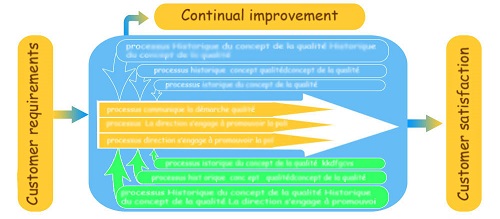
Par excellence processactivities which transform inputs into outputs (see also ISO 9000, 3.4.1) "mapping" is a multidisciplinary work. This is not a formal requirementexplicit or implicit need or expectation (see also ISO 9000, 3.1.2) of ISO 14971 but is always welcome.
The three types of processes and some interactions are shown in figure 3-3 and D 02. 
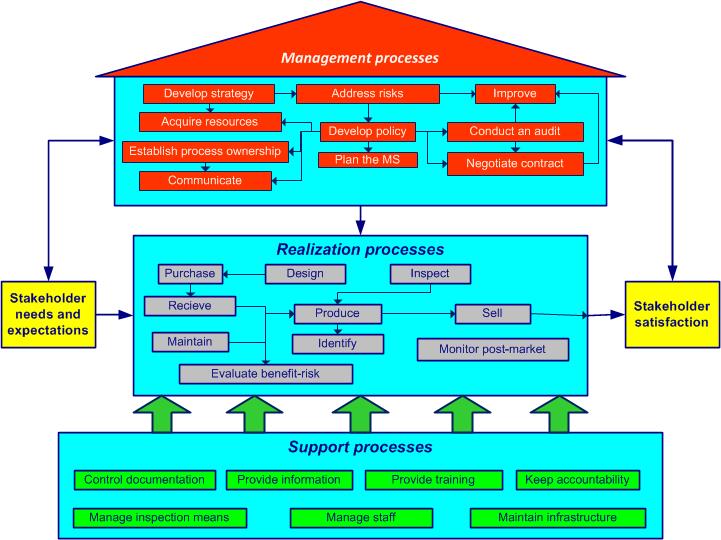
Figure 3-3. Process house
The mapping, among other things, lets you:
- obtain a global vision of the company
- identify the beneficiaries (customers), flow and interactions
- define rules (simple) for communication between processes
.jpg)
- develop strategy
- manage risks
- develop policy
- plan the MS
- deploy objectives
- acquire resources
- establish process ownership
- improve
.jpg) Minute of relaxation. Game: Process
Minute of relaxation. Game: Process
3.3 Process approach
Process approach, Deming cycle
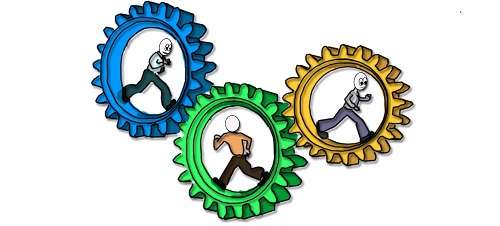
Simple solutions for now, perfection for later
The fourth principle of quality management is “Process approach” (see ISO 9000, 2.3.4). Some benefits:
- obtain a global vision of the company thanks to the mapping
- identify and manage responsibilities and resources
- achieve effective management of the company based on process indicators
- manage risks that could influence the objectives
Process approach: management by the processes to better satisfy customers, improve the effectiveness of all processes and increase global efficiency
When the process approachmanagement by the processes to better satisfy customers, improve the effectiveness of all processes and increase global efficiency (see also ISO 9004, Annexe B.5) is integrated during the development, implementation and continual improvement of a management system, it allows one to achieve objectives that are related to customer satisfactiontop priority objective of every quality management system (see also ISO 9000, 3.1.4), as is shown in figure 3-4 (cf. ISO 9001, 0.2).
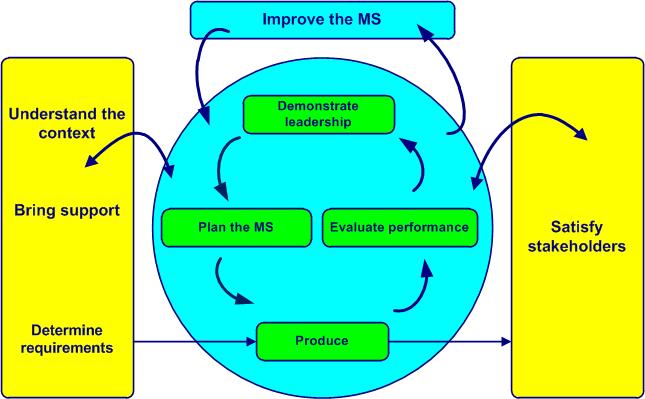
Figure 3-6. Model of an MS based on the process approach and continual improvement
The process approachmanagement by the processes to better satisfy customers, improve the effectiveness of all processes and increase global efficiency (see also ISO 9004, Annexe B.5) (cf. annex 08):
- emphasizes the importance of:
- understanding and complying with customer requirements
- prevention so to react to unwanted elements such as:
- customer returns
- waste
- measuring process performance, effectiveness and efficiency
- permanently improving objectives based on pertinent measurements
- process added value
- relies on:
- methodical identification
- interactions
- the sequence and
- process management, which consists of:
- determining objectives and their indicators
- piloting related activities
- analyzing obtained results
- permanently undertaking improvements
- allows one to:
- better view inputs and outputs and their relationship
- clarify roles and responsibilities
- judiciously assign necessary resources
- break down barriers between departments
- decrease costs, delays and waste
- and ensures in the long run:
- control
- monitoring and
- improvement of processes
- crisis management ("You will not solve the problems by addressing the effects")
- blaming people ("Poor quality is the result of poor management." Masaaki Imai)
- prioritizing investments ( "Use your brain, not your money." Taiichi Ohno)
The PDCA cycle, also called the Deming cycle, applies to the control of any processactivities which transform inputs into outputs (see also ISO 9000, 3.4.1), including the integration of risk management into the framework of the company. The PDCA cycles (Plan, Do, Check, Act) are a universal basis for continual improvementpermanent process allowing the improvement of the global performance of the organization (see also ISO 9000, 3.2.13 and ISO 14 001, 3.2) (see figure 3-5).
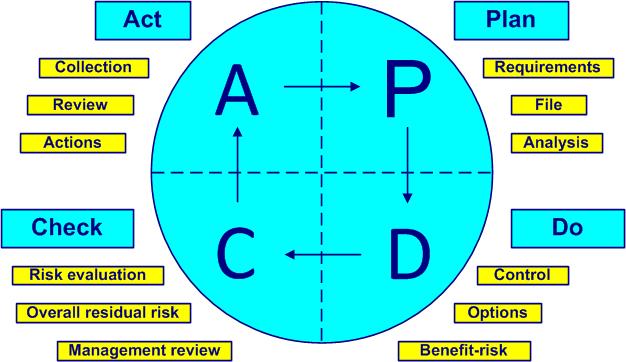
Figure 3-5. The Deming cycle for risk management
- • Plan – define requirements, demonstrate leadership, establish the risk management file, analyze risks, identify hazards (clauses 4, and 5)
- • Do – control risks, choose options for risk control measures, analyze benefits in relation to risks (clause 7)
- • Check – verify, evaluate risk, evaluate overall residual risk, review risk management (clauses 6, 8 and 9)
- • Act – collect feedback, review the information collected, take necessary actions (clause 10)
To learn more about the Deming cycle and its 14 points of management theory, you can consult the book “Out of the Crisis” W. Edwards Deming, Economica, 2002, first published in 1982.
 Minute of relaxation. Paganini's violin concert performed with facial expressions.
Minute of relaxation. Paganini's violin concert performed with facial expressions.
